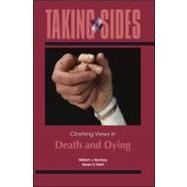
Note: Supplemental materials are not guaranteed with Rental or Used book purchases.
Purchase Benefits
What is included with this book?
Table of Contents Clashing Views in Death and Dying Unit 1 End-of-Life Decision Making
Unit 2 Caregiver End-of-Life Decision Making
Unit 3 Treatment Requests and Decisions: Pain and Futility
Unit 4 Assisted Suicide
Unit 5 Determining Definitions of Death
Unit 6 Hospice, Policy, and Costs of Dying
Unit 7 Dying and Death as Cultural Performances
|
The New copy of this book will include any supplemental materials advertised. Please check the title of the book to determine if it should include any access cards, study guides, lab manuals, CDs, etc.
The Used, Rental and eBook copies of this book are not guaranteed to include any supplemental materials. Typically, only the book itself is included. This is true even if the title states it includes any access cards, study guides, lab manuals, CDs, etc.